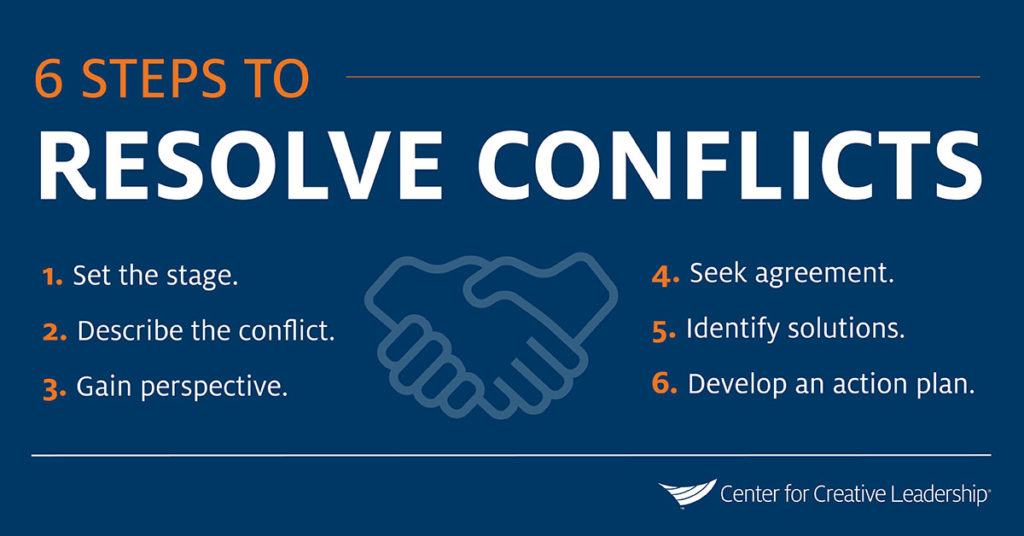How to Resolve Conflict in the Workplace
As a manager, you can’t take on everybody’s problems.
In the swirl of information and interactions, conflict will bubble and flare up, driven by disagreements, personal grievances, or misunderstandings. But getting drawn in doesn’t help others manage the conflict — nor does trying to figure out all the answers yourself.
So what can leaders do to manage conflict in the workplace? How can you help improve the situation and resolve conflict?
Dealing with conflict is a task many managers struggle with or even avoid. But it’s possible to transform disagreement and discord into positive outcomes.
3 Behaviors for Reducing Conflicts
The first step is to reduce conflict in the first place. There are real costs to conflict incompetence. Try these behaviors.
- Practice reflective thinking. Reflective thinking means weighing the pros and cons of the particular situation. Noting possible points you want to make before the conversation can help you focus on remaining open, listening actively without interrupting, or showing anger.
- Delay responding. This involves calling a time-out to let the situation calm. Delaying responding does not mean avoiding or ignoring the conflict — it just means taking a break so that people are better able to listen to one another. During a time-out, replace stressful thoughts with calm, reassuring ones.
- Commit to “adapting behavior.” Adapting behavior means staying flexible and trying to make the best out of the situation. Not every conflict can be solved in a totally satisfactory manner, but if you go into the conversation with an adaptable leadership approach and flexible mindset, you’ll more easily be able to make adjustments to prevent problems in the future.
Sometimes, though, conflict in the workplace can’t be avoided. When that happens, you’ll need to show leadership through it. Here are our 6 tips for leading through conflict.
How to Lead Through Conflict in the Workplace

1. Set the stage.
Start by creating an atmosphere of openness, constructive criticism, and problem solving. You want your colleagues to understand that you’re focused on the future, not the past — and that you’re optimistic things will work out. Follow these guidelines to set the stage for problem-solving:
- Express your sincere desire to understand.
- If you’re involved with the conflict, admit responsibility for your contribution, and ask what you can do to make amends.
- Emphasize that you want to work together to achieve a mutually satisfactory solution.
2. Describe the conflict.
Describe the conflict from your perspective as objectively, clearly, and specifically as you can. Talk honestly and directly to the other person. Express your emotions, but choose your words carefully, keeping them both courteous and professional. Explain how you feel and why. Consider how you want to be viewed after the conflict is over.
While many people are uncomfortable talking about emotions in the workplace, it’s better to express emotions in a forthright, appropriate way rather than having pent-up emotions gush out. To appropriately address emotions:
- Express information in a way that casts no blame.
- Be sure that expressing emotions is helpful.
- Don’t let your own hot buttons interfere with the process.
- Be specific. Instead of “I feel bad,” say, “I am frustrated because …”
- Use the “I” word instead of “You,” as in: “I am disappointed that the conflict came to this point.” Not: “You are to blame for this mess.”
3. Gain perspective.
It’s helpful to imagine what your colleagues are thinking and feeling. Don’t assume you understand all the facts. Setting aside your assumptions, what questions will you ask to understand others’ perspectives and to confirm or disconfirm your hypothesis?
As they answer, practice active listening and try to understand where they’re coming from. Acknowledge when you understand by rephrasing, restating, or summarizing, and ask for examples to clarify the issues when you don’t.
4. Seek agreement.
Identify potential points of mutual agreement and areas of disagreement. This is the first step in arriving at a solution.
5. Identify solutions.
From there, come up with possible solutions that help further everyone’s motives, goals, and agendas. Don’t evaluate them yet — your priority is just to generate new ideas. As you discuss, express alternative viewpoints in the form of a question, such as, “Would another solution be X?” Most importantly, be willing to compromise. Remember, you’re looking for a reasonable solution, not a victory.
6. Develop an action plan.
Establish a plan with specific actions that you’re both willing to take to implement the solution. Express your appreciation for everything the person contributed to the problem-solving session. Communicate your willingness to meet again to check on progress.
Remember that as a leader, even though you can initiate a constructive conversation, the effort always involves dialogue and discussion among the people involved. Adopt a positive attitude toward the conflict, find the best in people and in the situation, and maintain your sense of humor. Absorbing these lessons will make you a leader who’s able to calm conflict.
Author
Originally posted in CCL’s Leading Effectively Blog. Eckerd College has been a network associate of CCL since 1981.




